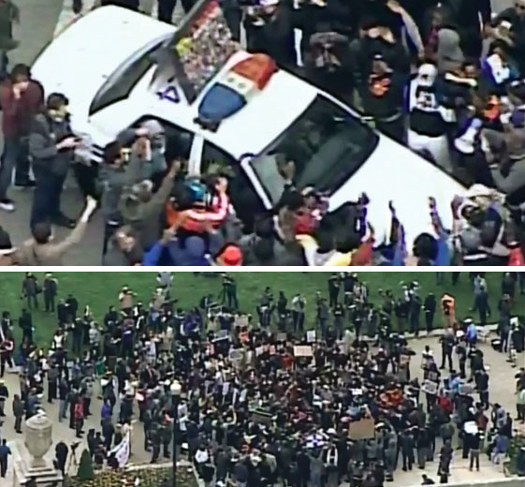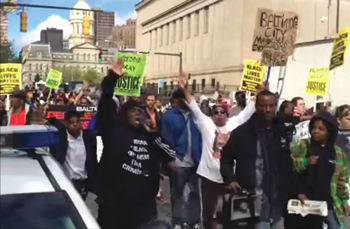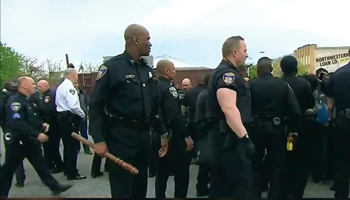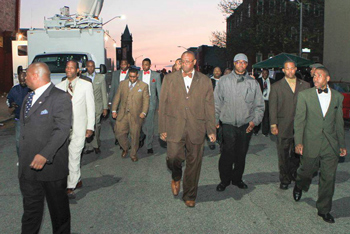
The head of the Baltimore Police Department has admitted some clear violations in the handling of 25-year-old Freddie Gray, who ended up with a severed spine, and whose death has focused national and international attention on a town that once dubbed itself “Charm City.”
Speaking April 24 at a Friday afternoon press conference, Police Commissioner Anthony Batts and police officials stated plainly that the victim should have received medical assistance at the place where he was arrested, the victim should have received medical attention when asking for help in a police paddy wagon and that the young Black man should have been strapped into the vehicle that was transporting him. He was not.

The officers involved in the arrest have stated that there was no force used to arrest Mr. Gray and there was no injury in trying to get Mr. Gray into the police vehicle. Attorney William “Billy” Murphy, Jr., told the media: “His take-down and arrest without probable cause occurred under a police video camera, which taped everything including the police dragging and throwing Freddy into a police vehicle while he screamed in pain.
“While in police custody, his spine was 80 percent severed at his neck. He lapsed into a coma, died, was resuscitated, stayed in a coma and on Monday, underwent extensive surgery at Shock Trauma to save his life. He clung to life for seven days and died today at approximately 7am.” His statement was released April 18.
Since that time demonstrators have taken to the streets of Baltimore and the Fruit of Islam of Muhammad Mosque No. 6 and Nation of Islam Student Minister Carlos Muhammad have been in the midst of the people, acting as true public servants by trying to help keep unarmed Black people and Black youth, in particular, from being hurt or killed.

Throughout this ordeal, the mainstream media has tried to in some way justify or explain away police actions–and a young Black male ending up with a severed spine–by saying he ran from police, didn’t police have a right to pursue him? Wasn’t this a high crime area and so wouldn’t this be suspicious?
No. “The city of Baltimore–which is investigating whether police misconduct played a part in Freddie Gray’s death–continues to pay out tens of thousands of dollars in settlements for lawsuits alleging brutality,” reported the Baltimore Sun.
“In the last two weeks, for example, the city’s spending board approved two settlements totaling $255,000. One lawsuit was filed by the estate of a man shot and killed by police in 2012. The other was filed by a man who said he incurred more than $55,000 in medical and dental expenses after being punched by an officer in 2011.
“Overall, the city has paid roughly $6.3 million since 2011 to settle police misconduct claims, according to a Baltimore Sun review of city and court records,” the newspaper reported April 22. It also confirmed police lawsuits for 2013 and 2014 show a decline in suits filed that accuse officers of misconduct and the city’s mayor has said there is still work to be done.

“A Sun investigation revealed last fall that the city spent $5.7 million in 102 court judgments and settlements for alleged police misconduct since 2011; since then, there has been an additional $587,250 in payouts. The investigation showed that city residents–including a pregnant woman and an 87-year-old grandmother–received battered faces, broken bones and other injuries during questionable arrests. Many of the lawsuits filed in recent years have been settled; in such settlements, the city and police officers do not acknowledge liability for alleged injuries. City lawyers have said that lawsuits against police are sometimes settled because the cost of litigation is high. In the recent $175,000 settlement for the man killed by police in 2012, city lawyers cited the unpredictability of jury verdicts and conflicting accounts of the incident,” the Sun reported.
Given that an 87-year-old woman and a pregnant woman can be beaten by police is it any wonder that young Black men, illegally targeted for stop and frisk and harassment, would choose to run, whether they were guilty or innocent.
In Freddie Gray’s case nothing was found on him that would appear to justify the focus of police officers. He was not found carrying weapons nor drugs. He had a small knife that his family insists was of legal size for him to carry.
As the attorney for the Gray family observed, the victim’s problem is that he didn’t run fast enough.
It is common in Black neighborhoods for officers, White officers in particular, feel free to target and terrorize residents. It could be for a perceived slight, it could be from a previous arrest, it could be from a spurned sexual advance or it could be generated by a refusal to sell drugs or engage in crimes for police officers.
And while White analysts and White journalists can pontificate about the hazards of police work and the dangers of ghetto life, it is Black people who suffer daily humiliation and daily subjugation who know the smothering reality of life under legalized racial oppression with nowhere to run.
Egregious assaults captured on videotape, eyewitness testimony, records of multiple abuses by police officers, public protests, pray-ins, candlelight vigils and federal investigations don’t guarantee charges–let alone a small thing called justice.
The question isn’t whether police officers had a reason to chase Freddie Gray. The question is why did he feel a need to run for his life?












